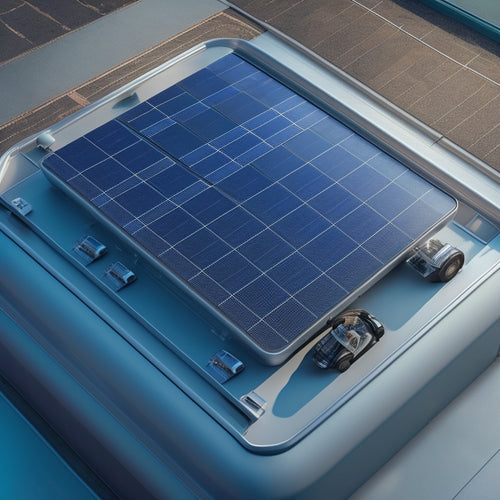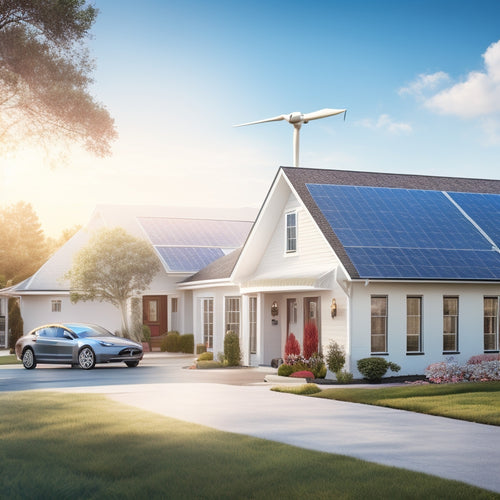
What Are the Key Factors in Solar Energy System Costs
Share
When considering a solar energy system, you'll want to factor in several key cost components. System size and complexity, equipment quality and brand, installation company and labor, roof size and material, local permitting and inspections, and incentives and financing options all play a significant role in determining the overall cost. The larger the system, the more components and installation complexity, increasing costs. High-quality equipment, experienced installation teams, and efficient roof installations can reduce long-term expenses. Local permits, inspections, and financing options can also impact your bottom line. As you weigh these factors, you'll uncover the subtleties of solar energy system costs, and the details that will help you make an informed investment decision.
Key Takeaways
- System size and complexity, including orientation and mounting, significantly impact overall costs and energy production.
- Equipment quality and brand, including solar panels, inverters, and mounting hardware, affect system performance and longevity.
- Installation company and labor costs, including experience and market trends, influence project expenses and quality.
- Roof size and material, including asphalt shingles and metal roofs, determine installation efficiency and energy output.
- Local permitting and inspections, including fees and process, add to overall project costs and ensure compliance with building codes.
System Size and Complexity
System size greatly impacts the overall cost of a solar energy system, as larger systems requiring more components and complex installations drive up expenses.
When you're planning your solar energy system, you'll need to evaluate the ideal system size for your energy needs. A larger system may provide more power, but it also means higher upfront costs.
You'll also need to think about system orientation, which affects how much energy your system can produce. The best orientation varies depending on your location and the time of year, but generally, a south-facing orientation is best.
However, if your roof doesn't allow for this, you may need to contemplate alternative mounting options, which can increase costs.
Shading analysis is another important factor to evaluate. Even partial shading can notably reduce your system's energy output.
You'll need to assess potential shading obstacles, such as trees or nearby buildings, and adjust your system design accordingly.
Equipment Quality and Brand
Three key aspects of your solar energy system's equipment - panels, inverters, and mounting hardware - greatly impact overall costs. When it comes to panels, higher efficiency models may cost more upfront but can provide greater energy production over their lifespan. Inverters, which convert DC power to AC, vary in quality and features, affecting their price. Mounting hardware, including racking and tracking systems, also impacts costs.
| Equipment Component | Key Factors Affecting Cost | Impact on Overall Cost |
|---|---|---|
| Solar Panels | Panel efficiency, brand reputation, warranty coverage | Higher efficiency panels may cost more, but provide greater energy production |
| Inverters | Technological advancements, customer service, market trends | High-quality inverters with advanced features may be more expensive |
| Mounting Hardware | Product availability, long term reliability, brand reputation | High-quality mounting hardware may cost more, but guarantees secure installation |
You should consider these factors when evaluating equipment for your solar energy system. While high-quality equipment may come at a higher upfront cost, it can provide long-term benefits such as increased energy production, reduced maintenance, and improved system reliability.
Installation Company and Labor
When you're evaluating solar energy system costs, you need to take into account the installation company and labor costs.
A licensed and experienced team can greatly influence the overall cost of your system, as their skill and efficiency can reduce labor costs and guarantee a high-quality installation.
The labor costs and wages of the installation team will also affect your bottom line, so it's crucial to understand these factors to make an informed decision.
Licensed and Experienced Team
Hiring a licensed and experienced team is an essential step in getting your solar energy system up and running. You want to verify that the installation company you choose has the necessary team qualifications to handle your project efficiently and effectively. This includes checking their licenses, certifications, and insurance coverage.
| Team Qualifications | Project Experience |
|---|---|
| NABCEP certification | Residential and commercial installations |
| OSHA certification | Roof-mounted and ground-mounted systems |
| State licenses | Energy storage and grid-tie systems |
When evaluating a team's project experience, look for diversity in their portfolio. Have they worked on projects similar to yours? Do they have experience with energy storage and grid-tie systems? A team with diverse project experience can handle complex installations and overcome unexpected challenges. Additionally, a team with a proven track record of successful projects can provide you with peace of mind, knowing that your solar energy system is in good hands. By choosing a licensed and experienced team, you can guarantee a smooth and successful installation process.
Labor Costs and Wages
Behind the scenes of a successful solar energy system installation lies a team of skilled professionals, and their labor costs and wages play a significant role in the overall project expenses. As you consider investing in a solar energy system, it's crucial to understand the factors that influence labor costs and wages.
Here are four key factors that impact labor costs and wages:
-
Labor market trends: The demand for skilled laborers in your area can drive up wages, increasing project costs. Conversely, a surplus of skilled workers can lead to lower labor costs.
-
Wage fluctuations: Changes in minimum wage laws, union negotiations, or local market conditions can cause wage fluctuations, affecting the overall cost of the project.
-
Installation company size and structure: Larger companies with more overhead may charge higher labor rates, while smaller companies might offer more competitive pricing.
- Work complexity and duration: The complexity of the installation, including factors like roof type, system size, and electrical connections, can impact the number of labor hours required, increasing or decreasing labor costs accordingly.
Understanding these factors will help you better estimate labor costs and wages, ensuring a more accurate calculation of your solar energy system's total cost.
Roof Size and Material
As you prepare to install a solar energy system, considering your roof's size and material is significant. The roof's surface area will determine the number of solar panels you can fit, directly impacting your system's overall energy output. A larger roof allows for more panels, increasing your energy production. However, it also means higher costs due to the additional materials and labor required.
The type of roofing material is also important. For instance, asphalt shingles are a common choice, but they may require additional mounting hardware, adding to the overall cost. Metal roofs, on the other hand, can be more solar-friendly, allowing for a more efficient installation process.
When evaluating your roof's suitability, it's essential to conduct a shading analysis to identify areas that may receive insufficient sunlight. This guarantees ideal solar panel orientation, maximizing energy production.
Local Permitting and Inspections
When calculating the total cost of your solar energy system, you'll need to factor in local permitting and inspections, which can vary greatly depending on your location.
Permit application fees, for instance, can range from a few hundred to several thousand dollars, and are typically paid by you, the homeowner.
Additionally, inspection requirements can add to the overall cost, as they may necessitate multiple site visits by local authorities.
Permit Application Fees
Before installing a solar energy system, you'll need to secure necessary permits from local authorities, which involves submitting applications and paying associated fees. These fees can vary depending on the jurisdiction, type of permit, and complexity of the project.
The permit application process can be broken down into the following steps:
-
Determine required permits: Identify the necessary permits required by local authorities, which may include electrical, building, and zoning permits.
-
Prepare application documents: Gather and prepare all necessary documents, including system design plans, electrical schematics, and installation details.
-
Submit applications: Submit the permit applications to the relevant authorities, along with the associated fees.
- Wait for approval: Wait for the permits to be approved, which can take anywhere from a few days to several weeks, depending on the permit timeline.
Understanding the permit application fees and process can help you budget and plan your solar energy system installation more effectively.
Inspection Requirements
You've secured the necessary permits, but that's not the end of the local permitting process. Now, you'll need to prepare for inspections, which are a critical component of ensuring your solar energy system meets safety and performance standards.
Inspections can be categorized into several types, including electrical, mechanical, and fire safety inspections. The inspection frequency will depend on the jurisdiction and the complexity of your system. Typically, inspections occur at various stages of the installation process, including before, during, and after system commissioning.
You should expect inspectors to verify that your system complies with local building codes, electrical standards, and manufacturer specifications. They'll check the installation quality, electrical connections, and system performance.
Be prepared to provide documentation, such as system designs, electrical diagrams, and test results, to facilitate the inspection process. Failure to pass inspections can result in costly rework, delays, and even system shutdowns.
Consequently, it's important to factor in inspection requirements and associated costs into your overall project budget.
Incentives and Financing Options
How can you overcome the upfront costs of a solar energy system? One way is to take advantage of the various incentives and financing options available.
-
Tax Credits: The federal government offers a 26% tax credit on the total cost of your solar energy system. This can greatly reduce your upfront costs.
-
Government Grants: You may be eligible for government grants, which can help cover a portion of the installation costs.
-
Financing Options: Solar loans and financing options are available from various lenders, allowing you to spread the cost over time.
- Lease Agreements and Power Purchase Agreements: These options enable you to benefit from energy savings without owning the system, reducing your upfront costs to zero.
Frequently Asked Questions
Can I Install Solar Panels on a Rented Property?
As you weigh the possibility of utilizing the sun's power, you're faced with an essential question: can you install solar panels on rented property? You'll need to obtain permission from your landlord through renter agreements, and guarantee installation permissions are granted before moving forward.
How Long Does a Typical Solar Panel Installation Take?
You'll typically wait 2-5 months for a solar panel installation, with the project duration ranging from a few days to several weeks, depending on the complexity of the installation timeline and local permits.
Are Energy Storage Systems Compatible With Solar Panels?
You'll find that energy storage systems, like batteries, are indeed compatible with solar panels, allowing you to store excess energy generated during the day for later use, ensuring a reliable and efficient power supply.
Do Solar Panels Work During Power Outages?
As you're considering solar panel functionality, it's likely you're wondering if they'll work during power outages. Coincidentally, you're in luck - with the right power outage solutions, like a battery backup system, your solar panels can continue generating electricity even when the grid goes down.
Can I Monitor My Solar Energy System Remotely?
You can monitor your solar energy system remotely, tracking its performance and receiving alerts on any issues, using advanced remote monitoring systems that provide real-time data on your solar performance, energy production, and system health.
Related Posts
-

Why Go Green With Automotive Products Online?
By switching to eco-friendly automotive products online, you're taking a significant step towards reducing your carbo...
-

Top Solar Panels for Car Battery Maintenance
When selecting top solar panels for car battery maintenance, consider high-efficiency models with high wattage output...
-

Why Homeowners Are Embracing DIY Energy Independence
By taking control of your energy needs, you're breaking free from the uncertainty of utility bills and embracing a se...


